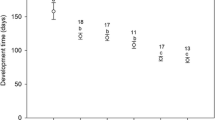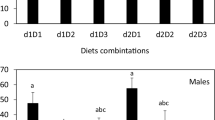Summary
Growth responses and accumulation of N and P were studied in two pygmy south-west Australian species of Drosera following supplementary feeding of arthropods (collembolans, Hypogastrura vernalis and fruit flies, Drosophila melanogaster) and/or a balanced mineral nutrient supplement (N as nitrate) via the roots. One feeding experiment used glasshouse-raised germlings from vegetative propagules (gemmae) of the perennial Drosera closterostigma, the other three (two on D. closterostigma and one on the annual D. glanduligera) involved natural populations engaging in natural captures of indigenous prey. All experiments recorded highly significant increases in plant dry matter, N and P (all plant age groups) and in reproductive performance (adult plants only) from artificial feeding of arthropods, but no apparent benefits from minerals alone or additive effects of minerals above that due to insects. Unresponsiveness to mineral nutrients was suggested to relate to inability of the species to use nitrate, while up to three-fold growth and nutrient uptake response to insects indicated that growth of natural populations might be severely limited by inadequate catches of prey. It is concluded that the highly nutrient-poor conditions typical of the habitat of pygmy species of Drosera may have promoted marked specialization towards carnivory and an attendant decline in ability to utilize soil-derived sources of nutrients.
Similar content being viewed by others
References
Aldenius J, Carlsson E, Karlsson S (1983) Effects of insect trapping on growth and nutrient content of Pinguicula vulgaris L. in relation to the nutrient content of the substrate. New Phytol 93: 53–59
Chandler GE, Anderson JW (1976) Studies on the nutrition and growth of Drosera species with special reference to the carnivorous habit. New Phytol 76: 129–141
Dixon KW, Pate JS, Bailey WJ (1980) Nitrogen nutrition of the tuberous sundew Drosera erythrorhiza Lindl. with special reference to catch of arthopod fauna by its glandular leaves. Aust J Bot 28: 283–297
Givnish TJ (1989) Ecology and evolution of carnivorous plants. In: Abrahamson WG (ed), Plant-animal interactions. McGraw-Hill, New York, pp 243–290
Givnish TJ, Burkhardt EK, Happel RE, Weintraub JD (1984) Carnivory in the bromeliad Brocchinia reducta, with a cost/benefit model for the general restriction of carnivory to sunny, moist, nutrient poor habitats. Am Nat 124: 479–497
Harder R (1963) Bütenbildung durch tierische Zusatznahrung und andere Faktoren bei Utricularia exoleta R. Braun. Planta 59: 459–771
Harder R, Zemlin I (1967) Förderung der Entwicklung und des Blühens von Pinguicula lusitanica durch Futterung in axenischer Kultur. Planta 73: 181–193
Harley JL, Harley EL (1987) A checklist of mycorrhiza in the Brithish flora. New Phytol 105 (Suppl)
Karlsson PS (1988) Seasonal patterns of nitrogen, phosphorus and potassium utilization by three Pinguicula species. Funct Ecol 2: 203–209
Karlsson PS, Carlsson B (1984) Why does Pinguicula vulgaris L. trap insects? New Phytol 97: 25–30
Karlsson PS, Nordell KO, Carlsson BÅ, Svensson BM (1991) The effect of soil nutrient status on prey utilization in four carnivorous plants. Oecologia 86: 1–7
Karlsson PS, Pate JS (1992) Resource allocation to gemma production and sexual reproduction in south west Autralian pygmy and stilt-form species of sundew (Drosera spp., Droseraceae). Aust J bot 40(3) (in press)
Lamont BB (1984) Specialised modes of nutrition. In: Pate JS, Beard JS (eds) Kwongan, plant life on the sandplain. Univ of Western Australia Press, Nedlands, pp 236–245
Lee JA, Stewart GR (1978) Ecological aspects of nitrogen assimilations. Adv Bot Res 6: 1–43
Lüttge Ü (1983) Ecophysiology of Carnivorous Plants. In: Lange OL, Nobel PS, Osmond CB and Ziegler H (eds) Encyclopedia of Plant Physiology NS 12C pp 489–517
Pate JS, Dixon KW (1978) Mineral nutrition of Drosera erythrorhiza Lindl. with special reference to its tuberous habit. Aust J Bot 26: 455–464
Pringsheim EG, Pringsheim O (1962) Axenic culture of Utricularia. Am J Bot 49: 898–901
Pringsheim EG, Pringsheim O (1967) Small contributions to the physiology of Utricularia. Z Pflanzenphysiol 57: 1–10
Schulze ED, Gebauer G, Schulze W, Pate JS (1991) The utilization of nitrogen from insect capture by different growth forms of Drosera from southwest Australia. Oecologia 87: 240–246
Schulze W, Schulze ED (1990) Insect capture and growth of the insectivorous Drosera rotundifolia L. Oecologia 82: 427–429
Small JGC, Hendrikz B (1974) Evidence for nitrate reductase activity in the carnivorous plant Drosera aliciae Hamlet. S Afr J Sci 70: 156–157
Small JGC, Onaret A, Grierson DS, Reunolds G (1977) Studies on insect-free growth, development and nitrate assimilating enzymes of Drosera aliciae Hamlet. New Phytol 79: 127–133
Sorenson DR, Jackson WT (1968) The utilizatio of Paramecia by the carnivorous plant Utricularia gibba. Planta 83: 166–170
Thum M (1986) Segregation of habitat and prey in two sympatric carnivorous plant species, Drosera rotundifolia and Drosera intermedia. Oecologia 70: 601–605
Thum M (1988) The significance of carnivory for the fitness of Drosera in its natural habitat. 1. The reactions of Drosera intermedia and D. rotundifolia to supplementary feeding. Oecologia 75: 472–480
Thum M (1989) The significance of opportunistic predators for the sympatric carnivorous plant species Drosera intermedia and Drosera rotundifolia. Oecologia 81: 379–400
Watson AP, Matthiesen JN, Springett BP (1982) Arthropod associates and macronutrient status of the red-ink sundes (Drosera erythrorhiza). Aust J Ecol 7: 13–22
Zamora R (1990) Observational and experimental study of a carnivorous plant — ant kleptobiotic interaction. Oikos 59: 368–372
Author information
Authors and Affiliations
Rights and permissions
About this article
Cite this article
Karlsson, P.S., Pate, J.S. Contrasting effects of supplementary feeding of insects or mineral nutrients on the growth and nitrogen and phosphorous economy of pygmy species of Drosera . Oecologia 92, 8–13 (1992). https://doi.org/10.1007/BF00317256
Received:
Accepted:
Issue Date:
DOI: https://doi.org/10.1007/BF00317256




